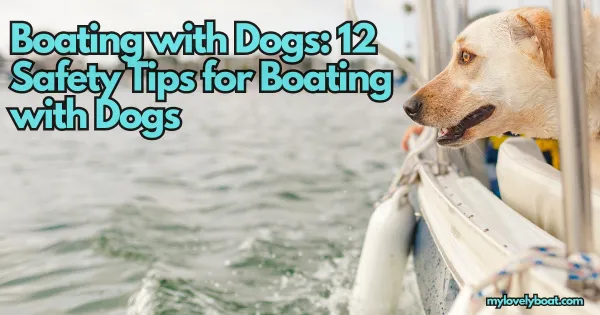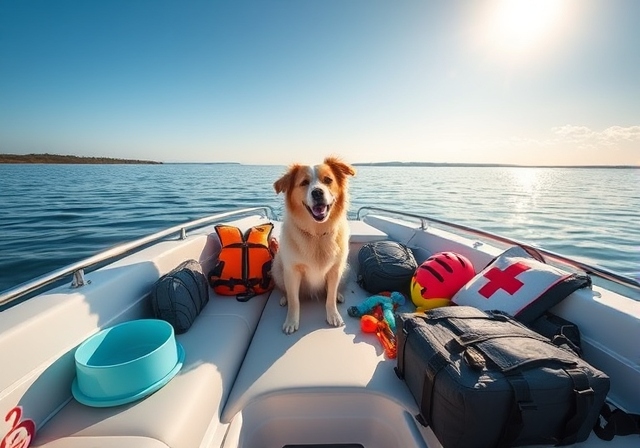Boating with Dogs: 12 Safety tips for boating with dogs

Taking your dog out on a boating adventure can be an incredibly fun and rewarding experience for both you and your furry friend. However, ensuring the safety of your pet on the water is paramount. Below, we’ve rounded up 12 essential safety tips for boating with your dog to ensure that everyone on board has a safe and enjoyable time
- Assess if Your Dog Likes Boating
- Train to Prevent Going Overboard
- Consider Pet Life Vests
- Provide Potty Breaks
- Prevent Your Dog from Slipping
- Know the Location of the Nearest Vet
- Create an Emergency Plan
- Pack a Doggy First Aid Kit
- Know the Rules
- Get a Canine Life Jacket
- Bring Doggy Sunscreen
- Pack Plenty of Water
1. Assess if Your Dog Likes Boating
Before embarking on a boating adventure with your canine friend, it’s crucial to determine if they actually enjoy the water and being on a boat.
Not all dogs are natural sailors; some might get anxious or seasick. Consider taking your dog on short test runs to gauge their reaction.
This initial step ensures that both you and your pet can have a positive experience.
Observing their behavior closely can provide key insights into whether longer trips would be enjoyable or stressful for them.
2. Train to Prevent Going Overboard
Training your dog how to behave on a boat is as important as training them for everyday life. Essential commands like “stay,” “sit,” and “come” can gain a new level of importance on a moving vessel.
It’s crucial to establish firm boundaries within the boat to prevent your dog from venturing too close to the edges and risking a fall overboard.
Such training involves not just obedience but also familiarizing them with the unique environment of a boat, which can move unpredictably.
3. Consider Pet Life Vests
No matter how proficient your dog is at swimming, wearing a life vest is an indispensable safety measure.
Life vests are designed to keep dogs afloat in situations where they might become fatigued or if they unexpectedly fall into the water.
These vests also often come with handles, allowing you to quickly and easily lift your dog back onto the boat if necessary.
Ensure the life vest fits snugly and comfortably, and choose one in a bright color for high visibility.
4. Provide Potty Breaks
One of the significant challenges of taking your dog boating is managing bathroom breaks, especially during longer trips.
Planning ahead by scheduling regular stops or creating a designated potty area on the boat can make the experience more enjoyable for everyone.
Some pet owners train their dogs to use a patch of artificial turf or a similar setup on the deck, which can help in managing this aspect smoothly and keeping your dog comfortable.
5. Prevent Your Dog from Slipping
Boat surfaces can be slippery, especially when wet, posing a risk for your dog to slip and injure themselves.
Implementing preventative measures such as non-slip mats or specially designed dog footwear can provide extra traction and stability for your pet. This is particularly important for older dogs or those with mobility issues.
Ensuring your dog can move safely around the boat adds to the enjoyment and safety of your water adventures.
6. Know the Location of the Nearest Vet
Before setting sail, it’s crucial to prepare for any emergencies by knowing the location of the nearest veterinarian or animal hospital along your route.
This preparation can make all the difference in the event of an unexpected illness or injury.
Research and note down contact information for vet services within a reasonable distance from your planned destinations, and consider a quick review of basic pet first aid before departure.
7. Create an Emergency Plan
Having an emergency plan in place for your dog is as critical as having one for human passengers. This plan should outline what to do if your dog goes overboard, falls ill, or gets injured.
It might involve drills for safely retrieving your dog from the water or a step-by-step response to health issues that could arise.
Discussing this plan with everyone on board ensures that all passengers are prepared to act quickly and effectively in case of an emergency.
8. Pack a Doggy First Aid Kit
A specialized first aid kit for your dog can be a lifesaver in case of minor injuries or ailments. This kit should include items like bandages, antiseptic wipes, tweezers for tick removal, and any medications your dog may require.
Having a first aid kit tailored to your dog’s needs ensures you’re prepared for a range of potential situations, from cuts and scrapes to emergencies requiring stabilization before reaching professional help.
9. Know the Rules
Boating with dogs, like any activity involving pets in public spaces, comes with its own set of rules and regulations.
These might vary depending on the location and type of water body you’re planning to navigate. Familiarizing yourself with local guidelines, such as leash laws or specific areas where dogs are not allowed,
can help prevent any inconveniences and ensure a smooth sailing experience for everyone involved.
10. Get a Canine Life Jacket
Highlighting the importance of a canine life jacket again underlines its significance in ensuring your dog’s safety on board.
A well-fitted life jacket not only offers buoyancy in the event of an accidental fall into the water but also provides peace of mind knowing that your pet is well-protected.
It’s one of the most straightforward and effective measures you can take to safeguard your furry friend during your boating adventures.
11. Bring Doggy Sunscreen
Just like humans, dogs can suffer from sunburn, especially those with short coats, light-coloured fur, or exposed skin.
Protecting your dog from harmful UV rays with pet-specific sunscreen is crucial during long periods of exposure on a boat. Apply sunscreen to your dog’s most vulnerable areas, such as the tips of their ears, nose, and back.
Reapplication is necessary after your dog goes swimming or every few hours to ensure continuous protection.
12. Pack Plenty of Water
Hydration is just as essential for your dog as it is for you, especially on hot days out on the water where heatstroke can be a risk.
It is necessary to bring along a sufficient supply of fresh, cool water and a drinking bowl (preferably a non-spill type for moving boats).
Encourage your dog to drink regularly throughout the day to prevent dehydration, which can quickly become serious in warm conditions.
Recommended Dog Water Bottles
- PetSafe Happy Ride Travel Dog Water Bottle: This bottle features a leak-proof design, built-in bowl, and is made from durable, BPA-free materials.
- MalsiPree Dog Water Bottle: Known for its one-hand operation and leak-proof design, this bottle is portable and convenient for boating trips.
conclusion
By following these comprehensive tips and dedicating time to training and preparation, you create a boating experience that is both enjoyable and safe for your dog.
Each step contributes to a seamless integration of your pet into your boating lifestyle, ensuring that every voyage is a pleasure for all involved.





